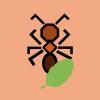Nope, me neither thank goodness! I'm not that huge.
Yeah it could be confusing, I mean my Lasius Niger colony does seem to have "no castes" besides queen, male, and worker. However, I think that the caste difference is just hard to notice until you observe closely. For example, my colony seems to mostly to have workers in the "Later Nanitic Worker" caste, probably because of a lack of threats, constant food supply, and a small colony size of about 100 workers (not for long though, the brood pile is getting huge). But if you compare this to the same species, which I found outside, 90% of these ants are all "Typical Worker of Mature Colony," perfectly adapted to predators, aphid tending and protecting, and the overall environment. I bet the variety of food they find out there probably helps, as well as the size of the colony. Very interesting stuff!
But you are correct, they do have castes, but they are simply less noticeable. This wouldn't quite qualify as "minor polymorphism" found in formica obscuripes, among others, or simply "polymorphic" such as Camponotus modoc, or the "Extreme polymorphism" in pheidole calafornica, with their massive classes of majors, that can be as big or bigger than the queen. Lasius brunneus, and Lasius niger, both neglect to produce the specialized major class, unlike other ant species.
Manica invidia (1 queen, ~200 workers)
Manica invidia (1 colonies, 1 queens plus 3 workers)
Lasius niger (single queen, ~200 workers - naturalistic, predatory set-up)
Lasius americanus (1 colony, ~10 workers)
Tetramorium immigrans (3 colonies, 3 queens, ~ five workers each | 1 colony, 1 queen, ~1200 workers)
Formica aserva (aserva queen, ~15 Formica neorufibarbis workers)
"And God made...everything that creeps on the ground according to its kind.
And God saw that it was good." - Genesis 1:25


















